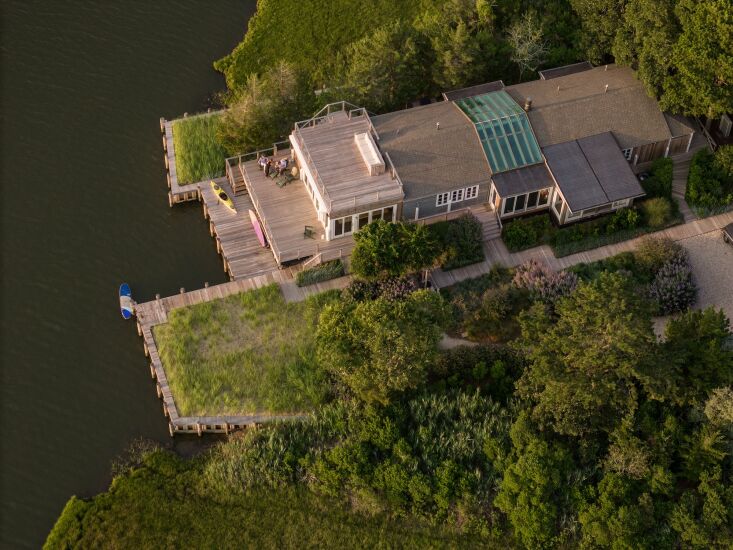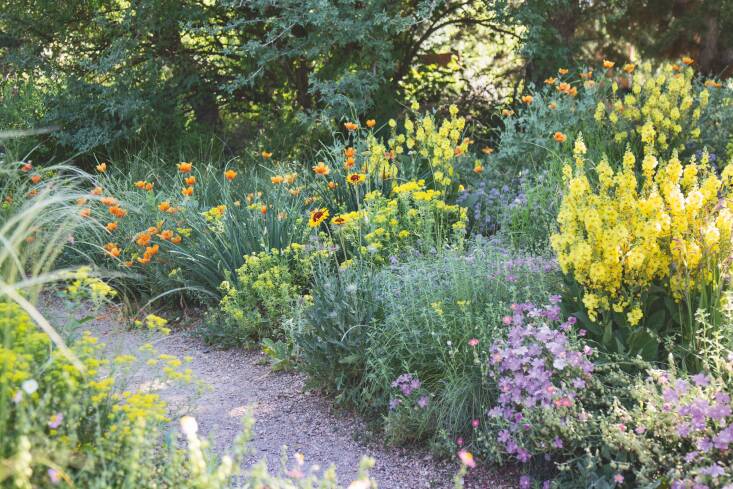It’s not every day that a client asks their landscape designer to come look at a barge they’re thinking of buying, but that was exactly the call the team at Hollander Design Landscape Architects received a few years back. The property in question was a house that had been built on a torpedo barge in the 1950s and docked on a harbor in the Hamptons ever since. The bulkhead was in need of a total rebuild—and the landscape would need restoration afterwards. Hollander Design was up for the challenge.
The clients ended up buying the house, and after a marine construction contractor rebuilt the bulkhead, walks, and the docks, Hollander Design returned to conduct major revegetation efforts. The clients were looking for a low-maintenance landscape, as they wanted the home to be a retreat from their busy, working lives. They desired a beautiful landscape, but they didn’t want a garden that would compete with the breathtaking setting. The trick would be to create the illusion that the barge and bulkhead were knitted into the marsh around them.
“Everything that’s around the house is very wet and boggy, but their property happens to be a high, dry spot because it’s up on that bulkhead,” explains landscape designer Melissa Reavis, the director of Hollander Design’s residential studio. “So we chose plants that were appropriate to that area but completely different from the immediate area that it sits in.” Think beach grass instead of the nearby rushes, plus, beach plums and northern bayberry that are found in nearby dunes.
In addition to its unique barge setting, the property experiences intense deer pressure (a challenge that many gardeners can relate to). Furthermore, the site is exposed to sea salt and increasingly frequent storm surges. “We were left with a pretty limited palette,” says Reavis, but she focussed on what she calls “bulletproof plants for a coastal environment” to create a garden that is almost as magical as its setting. Here, her formula for getting it right.
Photography by Neil Landino, courtesy of Hollander Design Landscape Architects.
The soil comes first.
Above: From overheard, you can see how the barge is tucked in behind the rebuilt bulkhead.
After the bulkhead rebuild, Hollander Design needed to replace a lot of the soil, which Reavis explains had been backfilled with whatever was on hand back in the 1950s. The new soil is mostly clean-draining sand, so that nutrients won’t leach into the water. “Everything that was replanted in that area is planted almost into direct sand and we don’t add any additional nutrient loads to the soil, to ensure that we weren’t affecting water quality around it,” Reavis explains.
Design for minimal maintenance.
 Above: Instead of a lawn, the main open area of the property is one over-sized perennial bed. The gravel path is used to bring kayaks and paddleboards down to the dock.
Above: Instead of a lawn, the main open area of the property is one over-sized perennial bed. The gravel path is used to bring kayaks and paddleboards down to the dock.
To fulfill the owners desire for a low-maintenance landscape, Reavis eschewed turf lawn and instead planted native and climate-adapted perennials. Hollander Design’s maintenance team does a hard cutback in May to keep the plants from outgrowing their homes, which also ensures a long bloom, but otherwise the maintenance is minimal—and free of pesticides, herbicides, and fertilizers.
Mimic the nearby aesthetic.
 Above: The American beachgrass planted on the bulkhead mimics the look of the native rushes in the surrounding wetlands, so your eye sees an almost uninterrupted swath of textured green.
Above: The American beachgrass planted on the bulkhead mimics the look of the native rushes in the surrounding wetlands, so your eye sees an almost uninterrupted swath of textured green.
“You feel completely enveloped by the harbor here,” says Reavis. “The landscape’s job here is just to make it feel as knitted into this magical world as possible.” To complement the landscape, Reavis pulled in not only native plants, but also climate-adapted ones that feel like they’re in the same world as the natural landscape beyond. “They’re all flowing grasses and flowing perennials, and so nothing feels out of place with the more native natural habitat,” says Reavis.
Mints for the win.
 Above: Russian sage ‘Denim n Lace’ is reliably deer- and rabbit-resistant.
Above: Russian sage ‘Denim n Lace’ is reliably deer- and rabbit-resistant.
Because the property is completely open to the landscape with no fencing, Reavis had to select plants that would be unappealing to deer and rabbits. Many of the species she chose, including Nepeta ‘Walkers Low’ and Russian sage ‘Denim n Lace,’ are in the mint family, whose aromatic leaves are unpalatable to critters. Reavis notes that mints are also great for pollinators because they bloom almost all summer long.
On an unfenced property many people resort to deer sprays, but that was not an option right on the water. “Deer sprays, even if they’re marketed as natural, have chemical additives in them that affect the horseshoe crab population. It’s really important to not use them anywhere near open water.” Reavis’s design proves that you can create something beautiful with only plants that deer won’t eat.
Plan for salt exposure.
 Above: Salt-tolerant Nepeta ‘Walker’s Low’ lines the boardwalk.
Above: Salt-tolerant Nepeta ‘Walker’s Low’ lines the boardwalk.
Hollander Design does lots of work near the bay and ocean, so they know what specific cultivars are more salt-tolerant than others. Reavis says she finds plants that stay more compact tend to be slightly more salt-resistant; for example, Nepeta ‘Walkers Low’ can tolerate salt better than other taller varieties of Nepeta. One tip if your garden gets soaked in salt water: Hose things down afterward. “It’s important not to let the salt build up in the soils,” says Reavis. “Sometimes just throwing a little bit of fresh water onto it is all you need to do.”
Choose hyper-local plants.
 Above: Drought-tolerant once established and beloved by hummingbirds and other pollinators, trumpet vine is one of the native plants Reavis selected for the site (it covers an arbor). It can be very aggressive, so be mindful where you plant it.
Above: Drought-tolerant once established and beloved by hummingbirds and other pollinators, trumpet vine is one of the native plants Reavis selected for the site (it covers an arbor). It can be very aggressive, so be mindful where you plant it.
Another way Reavis has built resilience into this garden is to use hyper-local plants, including a Long Island native Panicum called ‘Shore Orient,’ which was found in nearby Orient and stays compact. “More growers are starting to collect seed from local seed banks and grow for their own regions. Those are always going to be the most resilient plants,” Reavis says.
Right grass, right place.
 Above: The grass-lined gravel path.
Above: The grass-lined gravel path.
This project features many types of grasses, and what goes where was both an aesthetic and functional decision. Toward the parking area, Reavis used taller grasses to try to hide the cars a little bit more. Closer to the water, she used grasses that stay low to maintain views. Reavis avoided anything with burrs or sticky seed heads along the pathways because the clients have dogs. American beachgrass is planted along the bulkhead to mimic the texture of the rushes in the wetland.
Variety equals resilience.
 Above: Chaste tree, Russian sage, and butterfly bush are among the climate-adapted perennials that punctuate the swaths of mixed native grasses.
Above: Chaste tree, Russian sage, and butterfly bush are among the climate-adapted perennials that punctuate the swaths of mixed native grasses.
Reavis wanted the eye to move quickly across the landscape to the views of the water, but she didn’t want a simple plant palette because it is less resilient. “We try to use a lot of different grasses because with the odd winters that we’re getting now, we’re losing many more grasses than we had previously,” says Reavis. Her strategy was to plant ten different species of grasses. That way, if they do have a die-off one winter, they won’t lose them all. “You don’t want to plant an entire landscape with just three species because it’s very easy to lose one of them,” she explains. “Even if you’re just picking a few grasses, vary the cultivars so that it’s more likely that it’ll survive an odd climate issue.”
Embrace borrowed views.
 Above: Mature trees at the edges of the property were untouched by the construction, helping to blur the lines between the home landscape and the nearby preserved land.
Above: Mature trees at the edges of the property were untouched by the construction, helping to blur the lines between the home landscape and the nearby preserved land.
“I think there’s something to be said for a landscape that’s all about borrowed views,” says Reavis. “Beacuse this place is very outward looking, it’s allowed us to garden in a way that is so much more natural and thoughtful because it’s not about creating internal spaces for just this family. It’s all about connecting to the wild space.”
Relax a little.
 Above: A naturalistic garden can mean more time for leisure.
Above: A naturalistic garden can mean more time for leisure.
Not only is the garden designed to be low-maintenance and subtle, it is maintained differently than a traditional garden. “We let things move around more,” explains Reavis. “Things self-seed into there all the time. We have solidago that migrated in from the wild areas. But because it has that wilder look, we can be less precious about it.”
See also:



